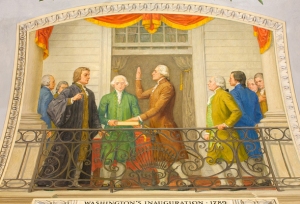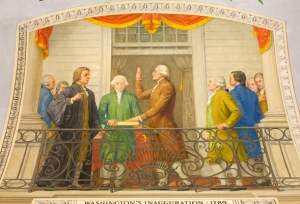–by Don Kennon
Prior to 1937, Inauguration Day was set on March 4th, as specified in the Constitution (the 20th Amendment changed the date to January 20th). The first inauguration, however, didn’t take place on March 4, 1789, but nearly two months later on April 30th. The First Federal Congress had convened on March 4, 1789, in New York City but the House of Representatives and the Senate each lacked a quorum necessary to do business, including counting the electoral votes cast for President and Vice President. On April 6th, enough Members had arrived to count the votes and declare Washington the winner. Congress dispatched Charles Thomson, the secretary of the old Continental Congress, to Mount Vernon to inform Washington of his victory. Thomson arrived at Mount Vernon on April 14 and two days later Washington started out for New York on a week-long triumphal procession which began one precedent no longer observed. Prior to 1889, inaugural parades went to the Capitol, accompanying the President-elect as he went to take the oath of office. The first post-oath parade was for Benjamin Harrison and included Buffalo Bill Cody and a group of cowboys.
When Washington arrived at New York on April 23d, the Senate was in the midst of a debate on what his title should be. Vice President Adams felt the presidency required a suitably dignified form of address. He favored “His Highness, the President of the United States and Protector of Their Liberties.” Others favored “His Serene Highness” or simply “His Excellency.” Just as Washington’s triumphal tour might have seemed excessive praise in a democracy, the debate over titles indicated some confusion over whether Washington was to be president or monarch. Several Members of Congress, however, ridiculed such haughty titles that reeked of royalty and aristocracy. Some referred to Adams behind his back as “His Rotundity,” or, in a prophetic reference to the role of vice presidents, “His Irrelevancy.” In the end, Congress wisely chose to use the title “the President of the United States.”
Because Congress met in Federal Hall, Washington went there to take the oath of office on April 30th. He went to the Senate Chamber on the second floor (hence the Senate has ever since been referred to as the upper house), where he was escorted out to the balcony to take the oath. Because there were no Supreme Court justices, the oath was administered by Robert Livingston, Chancellor of the State of New York. The Bible used in the ceremony was borrowed from nearby St. John’s Masonic Lodge when none could be found in Federal Hall.

Up until recently, historians’ accounts of Washington’s first inaugural included the claim that at the conclusion of the oath Washington added the phrase, “so help me God.” No contemporary accounts of the inauguration made reference to the phrase, and the first time the claim appeared in print was some 60 years later. Most scholars now accept that there is no credible evidence that Washington said “so help me God.” That, however, doesn’t mean that the oath itself lacked a religious connotation. It was taken on a Bible and, moreover, the wording of the oath, “I do solemnly swear,” was a clear and forceful reference to the religious sanction given to the oath. The word “solemn,” derived from the Latin solemnis (consecrated, holy) carried a stronger religious connotation in the late 18th century than it does today when to most it simply means “grave, serious, or somber.”
When Washington finished taking the oath, Livingston turned to the crowd and said, “Long live George Washington, President of the United States.” The flag was raised, artillery fired, and church bells pealed. The President then went back into the building and delivered his inaugural address in the Senate Chamber before both Houses of Congress.
Washington’s inauguration set one further precedent: it was followed by a ball. The ball wasn’t held that evening because Mrs. Washington hadn’t yet arrived from Mount Vernon. It was finally held on May 5th, even though she was still detained in Virginia. The President led two cotillions and danced a minuet, “well suited,” as one observer noted, “to his impressive dignity and courtliness.”
For further reading:
Peter Henriques, “So Help Me God”: A George Washington Myth that Should Be Discarded
Edward G. Lengel, Inventing George Washington: America’s Founder, in Myth and Memory (Harper, 2011)

nonononononononononononononononononononononononononononononononononononononononononononononononononononononononononononononononononononononononononononononononononononononononononononononononononononono
why
whhhhhhhhhhhhhhhhhhhhhhhhhhhhhhhhhhhhhhhhhhhhhy!!!!!!!!!!!!!!!!!!!!!!!!!!!!!!!!!!!!!!!!!!!!!!!!!!!!!!!!!!!!!!!!!!
Pfffff-
WORK
eliza uwu
Work. I Hate it. Its…
DISGUSTING!!!!!!! REEEEEEEEEEEEEEEEEEEEEEEEEEEEEEEEEEEEEEEEEEEEEEEEEEEEEEEEEEEEEEEEEEEEEEEEEEEEEEEEEEEEEEEEEEEEEEEEEEEEEEEEEEEEEEEEEEEEEEEEEEEEEEEEEEEEEEEEEEEEEEEEEEEEE!!! Also Hi Destiny UwU!
why are y’all leaving reply’s y’all should be working not wasting time messaging each other.